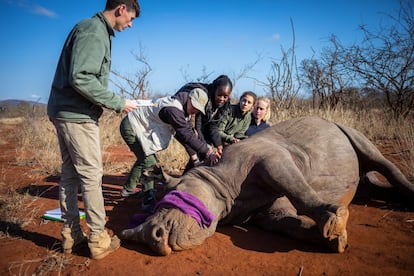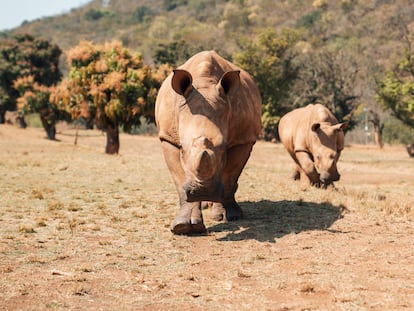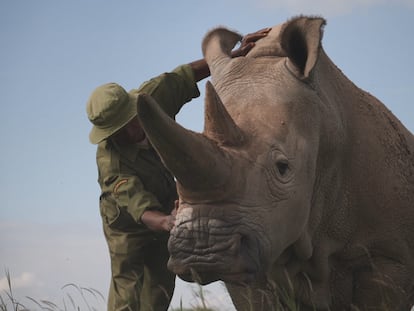South Africa rushes to dehorn rhinos to protect them from poachers
The extreme measure helps the species survive, but it’s not without its dangers: according to a study, dehorned rhinos reduce their home range because they feel more vulnerable

Rhino poaching in South Africa is on the rise, with the number of rhinos killed jumping from 448 in 2022 to 499 last year. The issue is taking an especially heavy toll on KwaZulu-Natal province, where authorities have adopted a radical measure, deciding to cut off rhino horns in a bid to save the animals’ lives. The operation began on April 8, but was not announced to the media until last Tuesday.
“With enormous regret, the organization has decided to dehorn, something that goes against what we defend, But the persistent threat posed by poachers makes drastic new measures necessary to protect our rhinos,” said Sihle Mkhize, the head of the Ezemvelo agency that is tasked with nature conservation in KwaZulu-Natal.
There are some 27,000 rhinoceroses of five different species left in the world, and South Africa is one of their last sanctuaries: thousands of tourists travel to the country’s nature reserves every year to see the imposing animal. However, the survival of the rhino is seriously threatened by poachers who kill them to remove their horn, which used in traditional Asian medicine for its supposed therapeutic effects — which have been proven to be nonexistent — or as a decorative element, with the horns going for a high price on the black market. In 2023 alone, 499 were killed in South Africa, two out of three (325) in the Kwazulu-Natal region, according to the South African Ministry of Environment.
Cutting off rhino horns is not a new measure. It began to be adopted in Zimbabwe and Namibia at the end of the 1980s, and in 2014, it spread to certain regions of South Africa with positive results. A key example is the Kruger National Park, where it was applied to 70% of the rhino population in the 2022-2023 period. However, this has pushed poachers to places where the animals still have their horns. This is the case of the Hluhluwe-iMfolozi reserve in Kwazulu-Natal, created in 1895 precisely to preserve rhinos, where 95% of the animals hunted in 2023 in the entire region were killed.
The procedure is complex. The animal has to first be sedated (usually a dart is fired at it from a helicopter). Then its eyes and ears must be covered so that it feels as little as possible. The horn is then cut with a chainsaw, leaving between 10 and 15 centimeters at the base. Horns are made up of a mix of calcium, melanin and keratin, and have a structure similar to horse hooves. The procedure is painless for the rhino and is over in about 15 minutes. The problem is that, since the horn grows to 12 centimeters a year, it must be cut again after between 18 and 24 months if the animal is to be saved from poachers. Kruger National Park estimates that each operation costs around €400 ($430).
Although Zimbabwean authorities previously claimed that cutting off the horns of rhinos has no negative impact on the animals, recent research indicates otherwise. A study published in 2023 in the scientific journal Proceedings of the National Academy of Sciences (PNAS), which coordinated by Professor Vanessa Duthé from the University of Neuchatel, shows that the process changes their behavior: dehorned rhinos decrease their home range and interact less with other rhinos.
After exhaustively following 368 black rhinos for 15 years in 10 South African reserves, Dr Duthé and her colleagues concluded that dehorning effectively protects against poaching and does not increase the rate of natural deaths. However, they did observe that dehorned animals reduced their home range by up to 45% and were much less likely to encounter other rhinos. “They are definitely aware of not having their horns anymore; they must be. So, we think it’s a confidence matter,” Duthé said in an interview for a PNAS podcast. “They probably feel a lot more vulnerable, and they decrease this explorative behavior that they usually have with horns [...] and stay in the more central parts of their home ranges. Specifically for these big dominant males that patrol actively, they will just reduce those patrols.”
In the expert’s opinion, dehorning could lead the rhinos into what she calls “ecological traps.” In other words, the rhinos reduce their home range and have access to fewer resources than if they kept their horns. But Duthé says that there are no indications that the growth of the population as a whole would be affected and that the long-term effects are yet to be determined, since genetic studies would be necessary.
Both the Kruger program and the one that has begun to be implemented in the Hluhluwe-iMfolozi reserve are supported by the World Wide Fund for Nature (WWF). The program is also supported by the majority of conservationists, who consider it an unfortunate but necessary measure in the face of the rise in poaching. The Ezemvelo agency said that the dehorning operation is part of a raft of decisions that includes investing €2.5 million in a sophisticated fencing system around the reserve, doubling the number of agents from 45 to 88, installing trackers in all vehicles, improving relations with nearby communities, and increasing aerial surveillance of helicopters and equipping them with night vision.
Sign up for our weekly newsletter to get more English-language news coverage from EL PAÍS USA Edition
Tu suscripción se está usando en otro dispositivo
¿Quieres añadir otro usuario a tu suscripción?
Si continúas leyendo en este dispositivo, no se podrá leer en el otro.
FlechaTu suscripción se está usando en otro dispositivo y solo puedes acceder a EL PAÍS desde un dispositivo a la vez.
Si quieres compartir tu cuenta, cambia tu suscripción a la modalidad Premium, así podrás añadir otro usuario. Cada uno accederá con su propia cuenta de email, lo que os permitirá personalizar vuestra experiencia en EL PAÍS.
¿Tienes una suscripción de empresa? Accede aquí para contratar más cuentas.
En el caso de no saber quién está usando tu cuenta, te recomendamos cambiar tu contraseña aquí.
Si decides continuar compartiendo tu cuenta, este mensaje se mostrará en tu dispositivo y en el de la otra persona que está usando tu cuenta de forma indefinida, afectando a tu experiencia de lectura. Puedes consultar aquí los términos y condiciones de la suscripción digital.











































